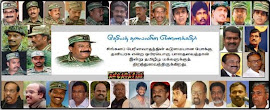கல்லறைகளையும்
சாம்பல் மேடுகளையும்
கொண்டே சாத்தியமாக்ப்படும்
என் கனவு தேசமே!
எத்தனை வலியகள் சுமந்தாய்
எத்தனை புயல்கள் கடந்தாய்
எத்தனை ஏமாற்றம் கண்டாய்
எதற்க்கும் சளைக்காத –என்
கனவு தேசமே!
நேற்றைய வேதனையை
வேதமாக்கிய உன்
வேள்விப்புருசர்கள்
நாளை உனை மீட்பர்
நொய்ந்து தினம் சாகும்
கோலத்தமிழினம்
உயந்து கொல்லும் பகை
என் கனவே தேசமே
காணமல் போய் விடாதே!
கருங்காலிகள் பலரின்
குள்ள நரித்தனத்தால்
காட்டிக் கொடுக்கப்பட்ட
என் கனவு தேசமே
கவலை கொள்ளாதே
பிரிவினில் வாடும் காதலர் என
அழுது நீ தவிப்பது புரிகிறது
உன் மகன் என் தலைவர்
அவர் காலடி உன் அடியில்
இருக்கும் வரை
அழுகை வேண்டாம்
என் கனவு தேசமே!
என் கனவு தேசமே
கல்லறையின் விதைப்பு உனக்காய்
காவலரணில் என் தோழனின்
விழிப்பும் உனக்காய் தான்
காத்திரு விழி பூத்திருக்கும்
உன் குழந்தைகள் உனை மீட்பர்.




0 comments:
Post a Comment